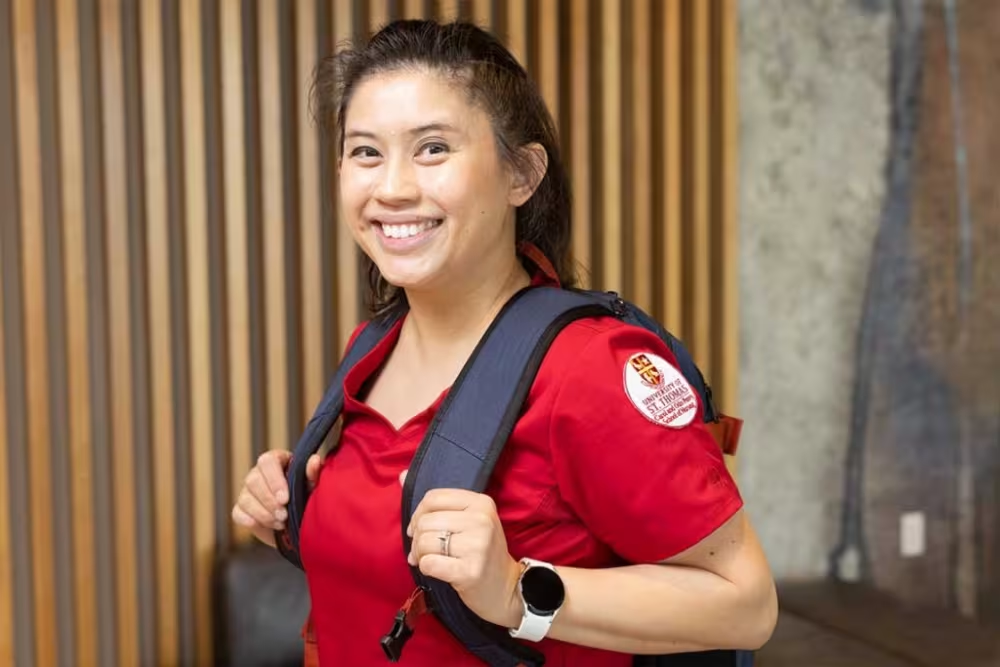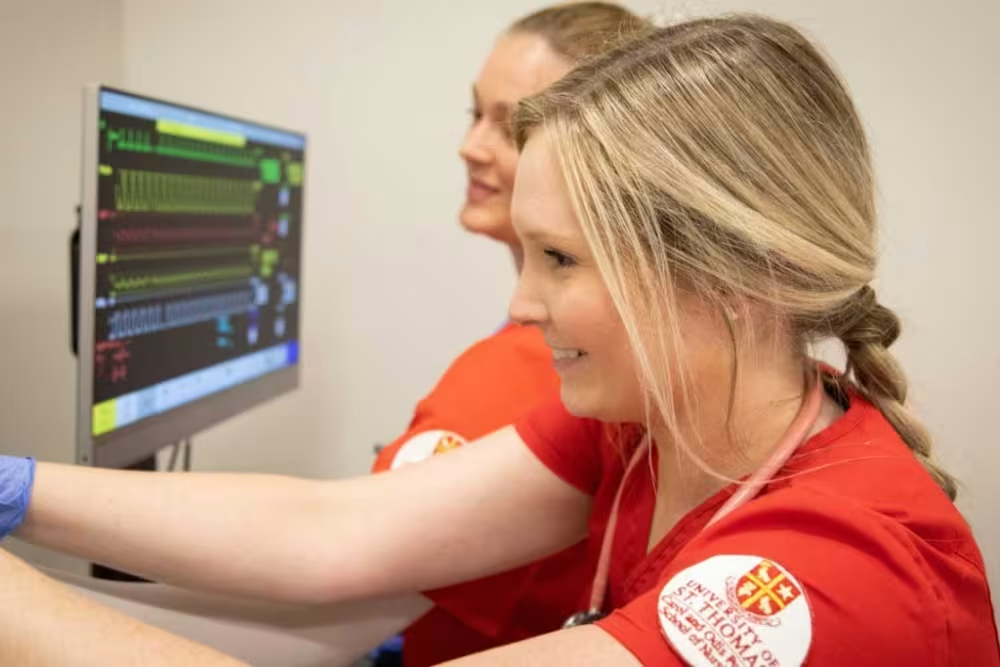How to Become a Nurse Practitioner without a Nursing Degree: 5 Steps
Each blog post is dated and contains accurate information as of that date. Certain information may have changed since the blog post publication date. If you would like to confirm the current accuracy of blog information, please visit our ABSN overview page or contact admissions at (855) 830-2713.
Author Bio: Founded in 1947, The University of St. Thomas has helped many aspiring nurses on their path toward a successful career in nursing through its Accelerated Nursing Program in Houston, Texas.
Curious about how to become a nurse practitioner without a nursing degree? If you have prior non-nursing college education, your first step toward meeting the nurse practitioner requirements is to earn a BSN. Then, you’ll need clinical experience, a graduate degree and board certification to become an NP.

If you hold a bachelor’s degree, it just may be the first step toward a career changing lives as a nurse practitioner (NP). An NP is an advanced practice registered nurse (APRN)—a highly educated and trained nursing professional who can practice with significant autonomy.
The role of a nurse practitioner is to help patients and offer them guidance, treatment and support. If you’re interested in learning how to become a nurse practitioner without a nursing degree, now is the time to leverage your prior experience into a career that is respected, needed, and in high demand.
According to the U.S. Bureau of Labor Statistics (BLS), the projected job growth rate for all APRNs will increase by 38% between 2022 and 2032. At this job growth rate, healthcare employers will need to hire about 123,600 new APRNs during this period.
Here, we’ll dive into how to become a nurse practitioner with a non-nursing bachelor’s degree and how the University of St. Thomas Houston’s Accelerated Bachelor of Science in Nursing (ABSN) program can help you graduate ready to sit for your nurse licensure exam in as few as 12 months. Once you obtain licensure, you’ll be prepared to tackle the remaining nurse practitioner requirements.

Interested in learning more about the different levels of nursing? Check out this blog.
What Is an NP?
A nurse practitioner is a registered nurse (RN) who holds a Master of Science in Nursing (MSN) or a Doctor of Nursing Practice (DNP) and has obtained specialty-specific board certification. NPs generally work in hospitals, outpatient care centers, urgent care clinics, community clinics and primary care centers.
Depending on their state of practice, specialization, and interests, NPs may choose to treat patients or focus more on administrative and research-based duties.
NPs are prepared to:
- Prescribe medications
- Promote disease prevention and a healthy lifestyle
- Evaluate patients and symptoms
- Conduct diagnostic tests
In some states, NPs are empowered to act as primary care physicians. More than half of U.S. states permit full practice authority to NPs — meaning NPs may treat patients, evaluate tests and prescribe medications without a supervising physician or physician assistant.

An NP may choose from a range of nursing specialties, including:
- Family nurse practitioner (FNP)
- Pediatric nurse practitioner (PNP)
- Adult-gerontology (AGNP)
- Psychiatric nurse practitioner (PMHNP)
- Neonatal nurse practitioner (NNP)
- Women’s health nurse practitioner (WHNP)
Now that you know what an NP is and what specialties they can pursue, let’s explore how to become a nurse practitioner without a nursing degree. You must meet several nurse practitioner requirements, and it all starts with leveraging your prior education to obtain a BSN.
Step 1: Use Your Non-Nursing Bachelor’s Degree to Become an RN
Your path toward meeting the nurse practitioner requirements with a non-nursing bachelor’s degree starts with enrolling in an ABSN program like the one offered at UST. While an NP career may seem far in the future now, you may be surprised at how soon you can earn your undergraduate nursing degree and start working as an RN.
Our accelerated program empowers you to leverage your previous degree so you can earn a bachelor’s degree in nursing in as few as 12 months instead of the four years a traditional BSN program will take to complete.
UST’s ABSN program builds the nursing foundation to pass the National Council Licensure Examination (NCLEX) and obtain licensure.
UST’s accelerated BSN program offers a comprehensive blended learning model that combines the following:
- Online curriculum
- Hands-on labs
- Clinical rotations
Step 2: Gain Clinical Work Experience
Enrolling in a graduate-level nursing degree program shortly after earning your BSN and obtaining licensure is possible. However, gaining at least one or two years of clinical work experience is better. This will allow you to continue to develop your skills and expand your nursing knowledge as you learn from other nurses in your department and work on various patient case types.

Getting work experience first also lets you know which nursing specialty you wish to pursue. Even if you have a firm idea of your intended specialty now, you might surprise yourself by changing your mind. For instance, let’s say you thought you wanted to focus on adult-gerontology. Still, after working for a year or so in adult gerontology, you might decide to focus on pediatrics instead. With a firmer idea of your future career path, you can apply to graduate programs that offer a concentration in your nursing specialty.
Step 3: Enroll in a Graduate Nursing Degree Program
After you’ve become an RN and obtained some work experience, the next step in the process of how to become a nurse practitioner is to earn your graduate degree. At this stage, you’ll have an important choice to make. You could pursue a Master of Science in Nursing (MSN) or a Doctor of Nursing Practice (DNP) degree.
A DNP degree will take longer to earn and will be more intensive. However, your efforts would be well worth it. Although it’s currently possible to become an NP with an MSN, there has been a push in recent years toward requiring a DNP for APRNs, including NPs.
The American Association of Colleges of Nursing (AACN) has called for requiring a DNP for APRNs by 2025. This means that by becoming an RN and gaining clinical experience, you may already be required to have a DNP instead of an MSN.
Step 4: Earn a Nurse Practitioner Certification
With sufficient clinical experience and a graduate degree in nursing, you will become eligible to pursue an NP certification. There are multiple NP certification boards. The one you choose largely depends upon your chosen specialty.
For instance, the Pediatric Nursing Certification Board (PNCB) administers board certification for NPs specializing in acute care or primary care in pediatrics. In contrast, the National Certification Corporation (NCC) administers accredited certifications for neonatal NPs and women’s health NPs.
Each board determines its own eligibility criteria, but you can generally expect to be required to submit proof of your graduate education and unencumbered RN license. Your graduate transcripts should reflect APRN-level courses. You’ll need to pass your selected board’s certification exam to obtain board certification.

Step 5: Obtain APRN Licensure to Meet Nurse Practitioner Requirements
It may seem odd that you must apply for licensure again since you’re already a licensed RN. However, after obtaining board certification as an NP, you will indeed need to apply for state licensure to work as an APRN officially.
Unfortunately, there isn’t a universally applicable procedure for all states. You must follow your state’s requirements for applying for NP licensure. In some states, an APRN license is considered an “upgraded” RN license.
Depending on the state, you may need further licensure for specific NP duties, like prescribing medications. To learn more about your state’s APRN licensure requirements, visit NursingLicensure.org.
Ready to get started? Explore how to apply for nursing school here.

How to Become a Nurse Practitioner at UST
Are you ready to become a nurse practitioner without a nursing degree? The first step is a conversation with our admissions counselors, who will help you determine if UST’s ABSN program is a good fit for you.
With three start dates available per year and a graduation timeline of as few as 12 months, you could be on your way toward becoming a practicing nurse sooner than you might think. Contact us today to take the first step.
